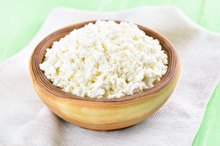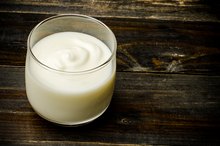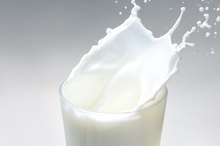Allergic Reaction to Cream Cheese
As a milk product, cream cheese belongs to one of the eight food groups that cause nine of every 10 food allergies, according to the Food Allergy & Anaphylaxis Network website. Approximately one in 40 children younger than 3 have allergies to milk products, notes the FAAN. Fifteen percent of them remain allergic for life, says Mount Sinai School of Medicine's Dr. Scott Sicherer.
Cream Cheese Allergens
A 1-ounce serving on cream cheese contains 1.68 g of milk proteins, according to the United States Department of Agriculture's National Nutrient Database. The two kinds of milk protein are caseins and whey. Solid casein proteins account for 80 percent of milk's volume. Adult allergic reactions to cream cheese may result from casein sensitivity. A study at the Mount Sinai School of Medicine, published in the April 1999 "Clinical and Experimental Allergy," found the highest casein sensitivity in milk-allergic children older than 9.
- A 1-ounce serving on cream cheese contains 1.68 g of milk proteins, according to the United States Department of Agriculture's National Nutrient Database.
- A study at the Mount Sinai School of Medicine, published in the April 1999 "Clinical and Experimental Allergy," found the highest casein sensitivity in milk-allergic children older than 9.
Allergic Response
Can I Be Allergic to Cottage Cheese?
Learn More
The cream-cheese manufacturing process uses the enzyme rennet to separate casein and whey proteins before draining off the whey. An allergic response to cream cheese occurs when the immune system mistakenly reacts to remaining casein protein as an infectious organism. This reaction triggers the release of IgE -- immunoglobulin E -- antibodies that specifically target the misidentified proteins. They stimulate the production of allergen-attacking chemicals, including histamines. Allergy symptoms follow, sometimes within minutes.
- The cream-cheese manufacturing process uses the enzyme rennet to separate casein and whey proteins before draining off the whey.
- This reaction triggers the release of IgE -- immunoglobulin E -- antibodies that specifically target the misidentified proteins.
Symptoms
Cream cheese and other milk allergies produce a range of skin, respiratory and digestive symptoms. The mildest reactions stop at itching or hives. Oral swelling, labored breathing, wheezing or nasal congestion and nausea, vomiting or diarrhea are more-serious symptoms. A life-threatening reaction is anaphylaxis. This systemic involvement begins with severe facial itching. Left unchecked, it causes throat swelling that interferes with breathing and swallowing. Digestive indications are cramps, vomiting and diarrhea. People in anaphylaxis often have confusion or blackouts from plunging blood pressure. This condition demands immediate medical treatment.
- Cream cheese and other milk allergies produce a range of skin, respiratory and digestive symptoms.
- The mildest reactions stop at itching or hives.
Allergic Reaction Versus Intolerance
Allergy to Yogurt
Learn More
Although they share digestive symptoms, allergic reactions to cream cheese and intolerance for it aren't the same. Food intolerance doesn't stem from an immune-system response. It results from the inability to digest the milk sugar lactose. Typical lactose-intolerance symptoms are nausea, gas, bloating and diarrhea. As a high-fat dairy product, cream cheese seldom causes serious intolerance.
- Although they share digestive symptoms, allergic reactions to cream cheese and intolerance for it aren't the same.
- As a high-fat dairy product, cream cheese seldom causes serious intolerance.
Management
The only way to prevent an allergic reaction to cream cheese is to stop eating it. With nearly 5 grams of fat -- including 3 grams of saturated fat -- in a single tablespoon, cream cheese is one food best eaten seldom and sparingly. Replace it with a low-fat, tofu-based cream-cheese substitute. Sacrificing the real thing may cost you some calcium and vitamin D. Up your spinach and broccoli intake to replace them.
- The only way to prevent an allergic reaction to cream cheese is to stop eating it.
- Sacrificing the real thing may cost you some calcium and vitamin D. Up your spinach and broccoli intake to replace them.
Related Articles
References
- "Clincal and Experimental Allergy": Cow's Milk Protein-Specific IgE Concentrations in Two Age Groups of Milk-Allergic Children and in Children Achieving Clinical Tolerance; SH Sicherer, HA Sampson; April 1999
- Cleveland Clinic Diseases & Conditions: Allergy Overview
- Cleveland Clinic Diseases & Conditions: Milk Allergies
- University of Michigan Health Service: Food Allergies and Intolerance
- Cheese, cream. U.S. Department of Agriculture. Published April 1, 2019.
- Butter, salted. U.S. Department of Agriculture. Published April 1, 2019.
- Cheese, cream, low fat. U.S. Department of Agriculture. Published April 1, 2019.
- Food Allergy. American Academy of Allergy, Asthma, and Immunology.
Writer Bio
Passionate for travel and the well-written word, Judy Wolfe is a professional writer with a Bachelor of Arts in English literature from Cal Poly Pomona and a certificate in advanced floral design. Her thousands of published articles cover topics from travel and gardening to pet care and technology.









